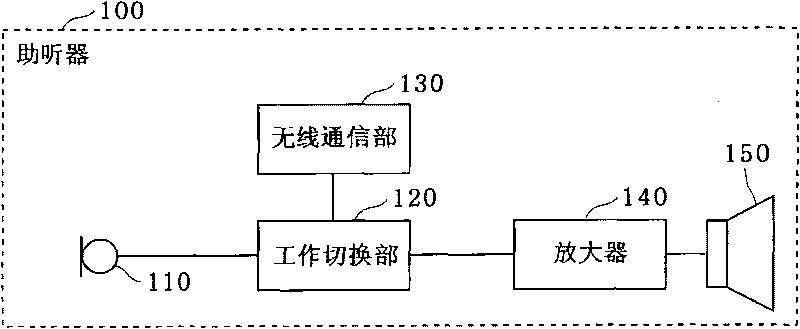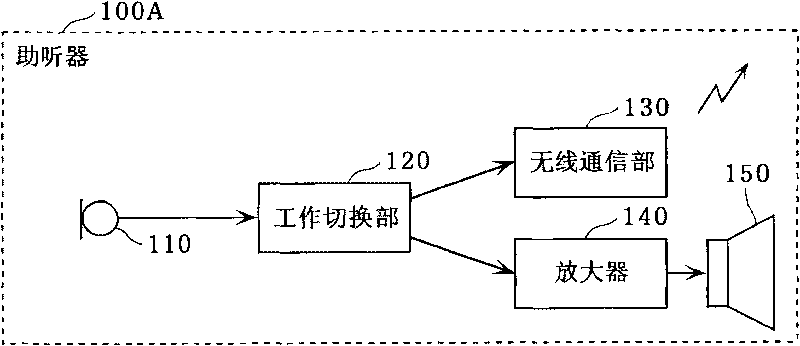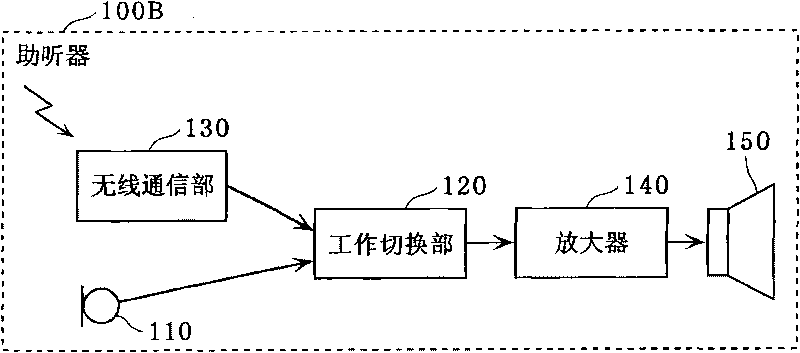Hearing aid, hearing aid apparatus, method of hearing aid method, and integrated circuit
A technology for hearing aids and external devices, applied in the directions of hearing aids, electrical components, transmission systems, etc., can solve problems such as troublesome hearing aids, and achieve the effect of being easy to find
- Summary
- Abstract
- Description
- Claims
- Application Information
AI Technical Summary
Problems solved by technology
Method used
Image
Examples
Embodiment 1
[0055] refer to Figure 1A ~ Figure 1C ,as well as figure 2 , the hearing aid according to Embodiment 1 of the present invention will be described. in addition, Figure 1A is a block diagram showing the configuration of the hearing aid 100 .
[0056] Hearing aid 100 according to Embodiment 1 of the present invention includes microphone 110 as a sound pickup unit, operation switching unit 120 , wireless communication unit 130 , amplifier (amplifying unit) 140 , and earphone 150 as an output unit. Typically, two hearing aids 100 having the same configuration are used as a set of binaural hearing aids (hearing aid devices).
[0057] The microphone 110 collects sounds around the hearing aid 100 . The operation switching unit 120 switches the operation mode of the hearing aid 100 . Specifically, the hearing aid mode, the search mode and the searched mode are interactively switched. The wireless communication unit 130 performs transmission and reception of signals with externa...
Embodiment 2
[0095] Second, refer to the attached Figure 3A and 3B, hearing aids 200A and 200B according to Embodiment 2 of the present invention will be described. in addition, Figure 3A It is a block diagram showing the data flow of hearing aid 200A operating in "hearing aid mode" and "search mode". Figure 3B It is a block diagram showing the data flow of the hearing aid 200B operating in the "hearing aid mode" and "searched mode". In addition, the same reference numerals are assigned to the same constituent elements as in the first embodiment, and detailed description thereof will be omitted.
[0096] Hearing aid 200B according to Example 2 further includes delayer (output delay unit) 260 between amplifier 140 and earphone 150 . The delayer 260 temporarily holds the sound output from the amplifier 140 and outputs it to the headphone 150 after delaying it for a predetermined time.
[0097] The operation switching unit 220 also performs the operation of controlling the delayer 260 ...
Embodiment 3
[0104] Second, refer to Figure 4A , Figure 4B , Figure 5A as well as Figure 5B Hearing aids 300A and 300B according to Embodiment 3 of the present invention will be described. in addition, Figure 4A It is a block diagram showing the data flow of the hearing aid 300A operating in the "hearing aid mode" and "search mode". Figure 4B It is a block diagram showing the data flow of the hearing aid 300B operating in the "hearing aid mode" and "searched mode". Figure 5A as well as Figure 5B It is a figure which shows an example of the hearing characteristic of a deaf person. In addition, the same reference numerals are assigned to the same constituent elements as those in Embodiment 1 and Embodiment 2, and detailed description thereof will be omitted.
[0105] The hearing aid 300B according to the third embodiment further includes a storage unit 370 and stores parameters 371 for each user. The storage unit 370 is constituted by, for example, a nonvolatile memory or the...
PUM
 Login to View More
Login to View More Abstract
Description
Claims
Application Information
 Login to View More
Login to View More - R&D
- Intellectual Property
- Life Sciences
- Materials
- Tech Scout
- Unparalleled Data Quality
- Higher Quality Content
- 60% Fewer Hallucinations
Browse by: Latest US Patents, China's latest patents, Technical Efficacy Thesaurus, Application Domain, Technology Topic, Popular Technical Reports.
© 2025 PatSnap. All rights reserved.Legal|Privacy policy|Modern Slavery Act Transparency Statement|Sitemap|About US| Contact US: help@patsnap.com



